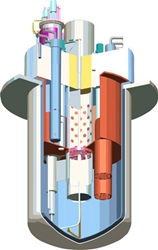Myrrha picked as European research infrastructure
01 December 2010
Three pan-European energy research infrastructures have been announced, including the Myrrha nuclear research reactor in Belgium, as part of the updated roadmap of the European Strategy Forum on Research Infrastructures (ESFRI).
 |
| A cutaway of Myrrha (Image: SCK-CEN) |
Myrrha (Multipurpose Hybrid Research Reactor for High-tech Applications) will be a sub-critical assembly relying on accelerated protons producing neutrons in the target to achieve periods of criticality in a low-enriched uranium core.
As well as being able to produce radioisotopes and doped silicon, Myrrha's research functions would be particularly well suited to investigating transmutation. This is when certain radioactive isotopes with long half lives are made to 'catch' a neutron and thereby change into a different isotope that will decay more quickly to a stable form with no radioactivity. If achievable on an industrial scale, transmutation could greatly simplify the permanent geologic disposal of radioactive waste. Myrrha can also be used to test the feasibility of Lead Fast reactor technology and is seen as complimentary to the Jules Horowitz Reactor, a thermal spectrum reactor under construction in Cadarache, France.
Earlier this year, the Belgian government gave the go-ahead for the construction of the facility at SCK-CEN's Mol site in northern Belgium. The country is to contribute 40% towards the €960 million ($1.3 billion) investment the project will require, but SCK-CEN is looking to set up an international consortium to ensure additional financing. The detailed engineering design of the facility is scheduled to be completed in 2014. Myrrha itself is scheduled for operation in 2023, but a reduced power model, Guinevere, became operational at Mol in March 2010.
European infrastructre
The Myrrha project is envisaged as a partnership of Belgium, the European Union, the European Investment Bank and other partners, with 70% of the funding from EU countries. Following an independent international evaluation, Belgium approved its 40% share of the funding in March 2010 - about €384 million ($500 million).
In addition to Myrrha, a wind research facility is planned in Denmark and a concentrated solar power installation in Spain have been announced by the European Commission. The overall investment in the three projects will be some €1.2 billion ($1.6 billion).
Maire Geoghegan-Quinn, European commissioner for research, innovation and science, said: "Developing world-class research infrastructure in Europe, by pooling resources at EU level, is an important objective of the 'Innovation Union'. These facilities will enable ground-breaking research and innovation and ultimately they could help to secure the EU's future energy supply. We need to bring research, technology, industry and market implementation closer together and that is the purpose of the European Strategic Energy Technology Plan."
In its updated roadmap, ESFRI has identified 50 new research infrastructures or major upgrades of existing ones, in order to stay at the forefront of research over the next 10-20 years. Their total construction cost amounts to some €20 billion ($26.2 billion) and their operational cost would be around €2 billion ($2.6 billion) per year.
One of the objectives of the Innovation Union is to launch by 2015 the construction of 60% of these priority European research infrastructures, primarily financed by EU member states, but with the support of European programs.
Besides Europe, Myrrha has attracted the attention of Chinese and Kazakh scientists. SCK-CEN has signed one agreement with the China Academy of Sciences, since China sees Myrrha as a way forward in treating its nuclear wastes. Another deal has come with KazAtomProm and the Kazakh National Nuclear Centre (NNC). SCK-CEN said that these agreements "constitute the first step towards these Asian countries' probable entry into the Myrrha consortium."
Researched and written
by World Nuclear News